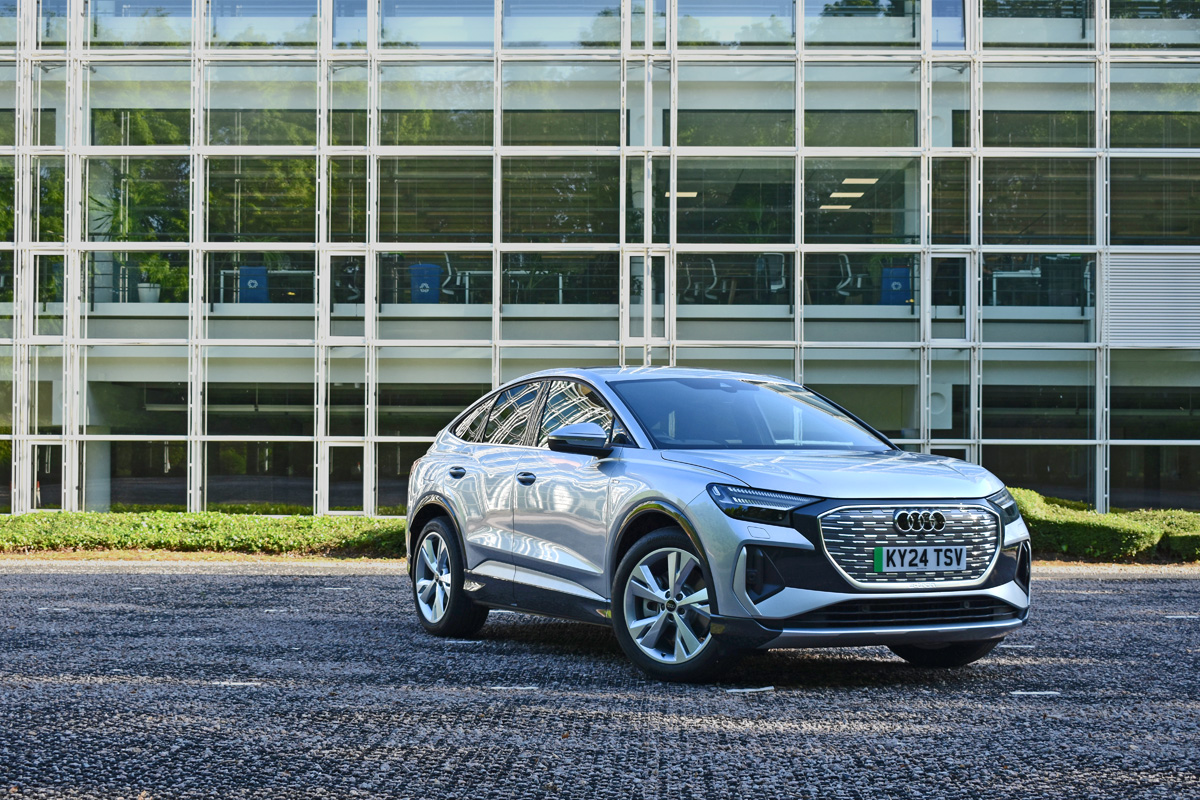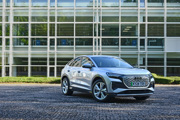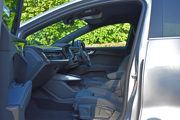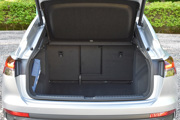Review
It's December and we’re now experiencing the full effects of winter with widespread snow and plummeting temperatures.
The early morning sub-zero temperature has had a significant effect on the Audi Q4 e-tron Sportback’s efficiency, with the previous warm-weather 3.8mi/kWh performances replaced by a below-par 2.6mi/kWh (and sometimes lower than that).
Consequently, the range has nose-dived from around 330 miles to below 240 miles at full charge, a drop of almost 30%.
It’s the biggest deterioration I can remember in any of the full electric cars I’ve driven, including some with last generation battery technology, such as the Jaguar iPace where efficiency dropped by around 20%.
That said, most of my weekly mileage still falls comfortably within the Q4’s reduced scope – which still remains greater than the WLTP best-case figures for many rivals - with just a handful of single journey trips requiring a top up on the noticeably more expensive public charging network.
Apart from the range, as a winter companion, the Q4 is generally doing a great job. The heaters warm the car quickly, even with the aircon switched off, and the heated seats appear to have a negligible impact on range.
The car (ours has Quatto all-wheel-drive) maintains grip well, including a recent commute to work which started on a thin covering of snow. The Sportback interior is spacious, although with slightly less rear headroom than the standard car, with decent boot capacity (535 litres).
A new find (even after almost six months we’re still unearthing additional treats!) is a handy angled bottle holder located at the front of the arm rest. It accommodates slightly wider containers than the central holders.
A slight niggle is the time it takes for CarPlay to connect; it’s often far from instant (and seems slower in the cold – or is that my imagination?), but this is a minor issue.
Another is the fiddly and occasionally overly sensitive steering wheel controls; I’ve lost count of the number of times I’ve accidently touched a switch and changed the binnacle display or turned the volume down.
Overall, the Q4 is a solid choice in this segment. Its personality may be a little bland, perhaps, but it has a good quality interior and does most things well, eliciting only a few – and mainly trifling - complaints.
Lighting up the road
A positive and a negative to report on this month as our journey with the Audi Q4 e-tron continues.
And, interestingly, neither of them has anything to do with the fact the car is full electric.
The positive relates to an area where Audi has shown leadership for many years and that’s lighting – specifically headlights.
Many manufacturers now offer some form of intelligent/adaptive headlights which automatically dim when cars approach. Some also have matrix headlights with LEDs igniting and fading to maximise the amount of road that is illuminated at any one time, without dazzling other road users.
They often react in blocks, which means quite a lot of road can remain in darkness, much akin to a manually operating headlight.
Audi’s Matrix LED headlights are, in my view, the best. Not once has any oncoming car flashed me (which I’ve had with several rival models that suffer from slower reactions) thanks to the intricate individual lighting sequences, which respond in microseconds.

The technology uses a camera system and optics to control the adaptive light output and distribution.
When other vehicles are detected, the system dims or turns off individual LEDs to mask the vehicle while still illuminating the surrounding area. They also shift the focal point of the light to follow the curve of the road.
It’s an impressive sight as the light rolls across the car to provide a carpet of illumination which can also pick out signage to alert the driver.
Our car also has Audi’s Technology Pack which includes LED-based dynamic indicators that illuminate sequentially to show which direction a vehicle is turning. They are intended to be more visible than standard turn signals in poor weather conditions.
Talking of poor weather, over the past few weeks we have seen ‘typical’ British weather – relentless rain and widespread surface water.
It has had a dramatic effect on the Audi’s efficiency. Journeys that were averaging 3.8mi/kWh have dropped to 3.2; fully charged range has slumped from 330 miles to 280. The temperature is still mild, so what is going on?
One obvious change caused by the weather is the constant use of the windscreen wipers, but they will not affect the range as they run off the 12-volt battery.
The answer was provided by James Rooney, head of fleet at Network Rail, and Matt Harris, fleet engineer at Centrica: it’s caused by the wet roads and, especially, driving through surface water which means the car’s tyres have to work overtime to squeeze out the water, bringing down the efficiency levels.
On the Audi, this is also likely to result in the car running in all-wheel mode more frequently, further draining the battery.
Of course, this isn’t unique to electric cars; it must also affect petrol and diesel cars.
But, as with most critical electric vehicle commentary, efficiency of ICE vehicles is rarely scrutinised in the same way.
Running costs compared
The Audi Q4 e-tron competes in an increasingly crowded sector, one which contains a broad range of electric models from manufacturers not historically viewed as premium brands.
We’ve selected three from a cross-section to provide a comparison of total cost of ownership using insight from the Fleet News TCO tool, with data supplied by Cap HPI: BMW iX2 xDrive 30 M Sport (the most obvious rival), Kia EV6 GT Line S AWD (the new pretender) and Tesla Model Y Long Range AWD (the market disrupter).
The headline figures do not make great reading for Audi. The Q4 is the most expensive (P11D of £58,190) and, subsequently, its total cost of ownership is the highest of the quartet.
At 59.54p per mile (ppm), the Audi will cost £47,632 over four years/80,000 miles. Compare that to the iX2, priced £57,390, which costs 56.63ppm or £45,304, the £56,220 EV6 at 58.80ppm/£47,040 and the table-topping Model Y, which has benefited from multiple price reductions over the past couple of years, to start at £52,935, costing 53.57ppm or £42,856.
Interestingly, despite unsettling the pricing guides with its repeated price drops, Tesla enjoys the best depreciation forecast, at 43.93ppm or £35,140, over the four-year term.
Audi leads the way on recharging costs at £1,911 over 80,000 miles (2.39ppm), just ahead of BMW and Tesla (2.43ppm/£1,946 and 2.45ppm/£1,958 respectively), but with clear water to Kia, at 2.61ppm/£2,085.
Our experiences with the Q4 e-tron suggest its WLTP figures are well within reach, which isn’t necessarily the case for the others, so the gap here could be greater than on paper.

In addition, the iX2 only has a 66kWh battery, so the range versus the 82kWh Q4 is likely to make its recharging costs much more expensive than those stated by Cap. Indeed the WLTP figures bear this out as, when viewing range and charging times, there are significant differences between those two cars.
The Q4 has an official WLTP range of 322 miles at 3.6mi/kWh efficiency. It can be rapid charged at a rate of 380 miles per hour, putting it in the middle of the pack.
At the other end of the scale is the BMW, whose efficiency of 3.7mi/kWh gives it range of up to 266 miles. Rapid charging speed is 330 miles per hour. Both range and charging speed put the iX2 at the bottom of the list.
The EV6 and Model Y have similarly sized batteries (77.4 and 78.1 respectively) and are the two fastest charging cars with the best range. The Model Y can be charged at 420 miles per hour and the EV6 at an incredible 570mph – theoretically, the Kia can be charged to full in just 34 minutes.
The Model Y just surpasses the Q4 for range, with a WLTP figure of 331 miles, also narrowly eclipsing the EV6’s 328 miles. Real-world figures, though, see the EV6 and Q4 jostling for top spot.
Service, repair and maintenance costs are similar across the four cars, with only BMW ducking below the 5ppm mark, at 4.8ppm.
Voting with the head, therefore, could leave the Q4 e-tron out in the cold, but brand strength and badge appeal would unlikely see it rejected from fleet choice lists, which puts the decision into the hands of the user-chooser.
With BIK rates so low – 2% this year, 3% next – P11D pricing differentials will have minimal impact on choice: the Q4 would cost a 40% taxpayer a smidge under £39 a month while the Model Y, as the cheapest, would cost £35.
Read our other reviews to build a full picture about the Q4’s driver appeal and its likely popularity on your choice list.
But, as a final sign off, so far this year (to end August), the Q4 has sold 10,913 units (5,454 in true fleet) compared to the EV6’s 3,963 and the iX2 on 1,325. Audi still trails the sector leader, though as the Tesla Model Y sits on 17,717 (with 14,245 in true fleet).
Impressive 'real-world' range
The Audi Q4 e-tron is achieving a consistent 3.8mi/kWh efficiency, which is typically giving up to 330 miles of range when fully charged.
Fully charged might be something of a sore point with Audi, though, as the manufacturer would prefer you predominantly charge to 80% to protect longevity of the battery. Best practice is to stay within a 20% to 80% margin to prevent possible long-term damage to efficiency levels.
That would give around 260 miles of range, which is fine for most purposes (and still noticeably more than the ‘real-world’ figure suggested by EV Database). Charging to 100% should only be for longer journeys.
That’s not to say even greater distances aren’t possible. A pre-conditioned battery, straight off the charger, with careful driving, puts 4.5mi/kWh within reach, giving a theoretical range getting close to 400 miles. That is substantially higher than the WLTP 3.6mi/kWh, but does require discipline, though.

Regenerative braking obviously helps to improve efficiency just as harsh acceleration destroys it.
We’ve also found that aircon can initially knock 20-30 miles off the range as it works to cool a hot car, but that negative impact drops to 5-10 miles when the temperature reaches the desired level. Optional ‘eco’ air flow saves a further five miles which still cooling the interior; setting the system to ‘max’ has the opposite effect.
Again, any drain on efficiency is mitigated by pre-conditioning the car while it is charging so it is at the correct temperature before being driven.
The is controlled via the My Audi app by setting the target time and temperature
It also gives updates on battery level, charging times to full, current mileage, vehicle warnings and information messages, as well as information about the car including owner’s manual, standard/optional equipment, colour, VIN and WLTP data.
You can even order digital extras for the car, such as remote access/parking location (£1) or additional virtual cockpit functions (from £1), and customise the interior themes with images and light effects. That’s more pricey, though, typically £10.99-14.99.
Easy to live with
The Audi Q4 e-tron is proving an easy car to live with. The comfort of a consistant 300-plus miles of range removes any anxiety – or desperation to charge at every opportunity. Hell, I’ve parked at work and shunned available charge points for three or four days, happy in the knowledge that the mid-size SUV has plenty of miles still available.
It’s also easy to drive, offering a relaxing experience with a suspension that is supple enough to cushion bumps but has enough stiffness to dispatch winding roads with minimum fuss.
It’s the same VW family MEB platform that underpins the Volkswagen ID4, Skoda Enyaq SUV and Ford Explorer.
The interior is sturdy with a mix of materials from stitched leather to both soft and hard plastics, plus gloss black accent surfaces.
The dashboard design features angles and directional changes, with the 11.6-inch infotainment screen tilted towards to the driver for improved vision and touchscreen access. It’s certainly not subtle, surrounded by dominant chunky air vents for the driver and a double dose of aircon apertures for the passenger.
Particularly pleasing for a family of four is the spacious interior, especially in the back with class-leading legroom and loads of headroom thanks to the high roofline afforded by the SUV silhouette. The 24-way seats are supportive with lumbar and side bolsters and integrated head restraints.
Audi’s Virtual Cockpit digital driver display offers multiple viewing configurations, including sat-nav, long- and short-term journey data, radio stations/Spotify playlists, phone contacts, battery charge levels and recuperation, and can also be arranged to prioritise key info, with different drive settings also changing the view.

There are some minor niggles, however. The touch sensitive controls on the steering wheel are fiddly, such as the volume control which requires a deft slide of the finger or thumb but often either doesn’t register or results in an ear-splitting blast of music.
It’s easier to control via a button on the centre console by sliding finger in a clockwise or anticlockwise motion.
Rear-view visibility is also slightly compromised, and not helped by the screen-splitting spoiler, but it’s largely overcome with a bit of mirror manipulation – and certainly nowhere near as restricted as the Volvo C40 we were previously testing.
Slightly more unnerving – at least initially – are the spongy brakes with the pedal travelling a fair distance before responding. Comments on several forums suggest others have experienced similar issues.
You get used to it, and you can augment the hard brakes with regenerative braking, but they are certainly not as responsive as electric models from rival manufacturers.
Audi Q4 e-tron Sportback 45 Quattro S Line joins our fleet
Audi is cresting the wave with the full electric Q4 e-tron, last year selling 16,757 units, which accounted for a quarter of registrations in its segment. Of those, 11,624 were true fleet.
Five months in to 2024, it is on track for a similarly dominant performance, with registrations just short of 7,000.
With a MY24 update last September, it’s the perfect time to be taking the Q4 e-tron as our next long-termer.
Our model is the mid-trim Sportback e-tron S Line 45 quattro (the line up starts with the Sport and is topped by the Black Edition), which is priced from £55,395.
With optional extras including Floret Silver metallic paint (£695), heat pump (£950) and Technology Pack (£1,495), our test car comes in at £59,060.

Included within the Technology Pack is a Sonos premium sound system, replacing the standard Audi offering, matrix LED headlights, wireless phone charging, and, in the rear, 12V socket and USB charging interfaces.
The S Line comes with a comprehensive list of standard equipment, including an abundance of safety tech, such as advanced driver attention and drowsiness monitor, Audi Pre-sense Front, lane departure warning with emergency assist and swerve/turn assist.
The spec also includes reversing camera, parking system plus, heated front seats, camera-based traffic sign recognition and 11.6-inch navigation/infotainment touchscreen.
The 82kWh battery (77kWh usable) charges at 11kW on AC and up to 175kW on DC with a minimum 10-80% charging time of 28 minutes (or 106 miles in 10 minutes).
Speedier charging times was one of the product updates, together with a newly tuned, sportier suspension, which is 15mm lower, and greater power (0-62mph is now a rapid 6.6 seconds).
WLTP range is 322 miles with consumption efficiency of 3.6mi/kWh (another update improvement, assisted by optimised thermal management).
It’s early days but, so far, we are achieving 3.8mi/kWh with full charge range indicating 330 miles, helped by the fact we’re now entering peak conditions for full electric vehicles thanks to the warmer summer weather.
Video: Audi UK walkaround
Specs
| Manufacturer | Audi |
| Model | Q4 E-Tron Sportback |
| Specification | Audi Q4 E-Tron Sportback 210kW 45 Quattro 82kWh S Line 5dr Auto [Lth/Tech] |
| Model Year | 2026.00 |
| Annual VED (Road tax) | £10 |
| BIK List Price | £57,475 |
| Range | 328.00mile(s) |
| CO2 | N/A |
| BIK Percentage | 3% |
| Insurance Group | N/A |
| CC | 1 |
| Fuel Type | Electric |
| Vehicle Type | Medium SUV |
| Luggage capacity (Seats up) | 535litres |
| Doors | 5 |
Running Costs
| P11D | £57,475 |
| Cost per mile | 68.12ppm |
| Residual value | £20,850 |
| Insurance group | N/A |
| Fuel Type | Electric |
| Cost per mile | 262.14ppm |
| Fuel | 2.40ppm |
| Depreciation | 257.05ppm |
| Service maintenance and repair | 2.69ppm |
Rivals
Info at a glance
-
P11D Price
£57,475
-
MPG
N/A (WLTP) -
CO2 Emissions
N/A -
BIK %
3% -
Running cost
3 Year 60k : £20,850 4 Year 80k : £17,000 -
Fuel Type
Electric -
Range
328.00mile(s)







































Login to comment
Comments
No comments have been made yet.